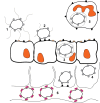Gonorrhea - an evolving disease of the new millennium
- PMID: 28357376
- PMCID: PMC5354566
- DOI: 10.15698/mic2016.09.524
Gonorrhea - an evolving disease of the new millennium
Abstract
Etiology, transmission and protection: Neisseria gonorrhoeae (the gonococcus) is the etiological agent for the strictly human sexually transmitted disease gonorrhea. Infections lead to limited immunity, therefore individuals can become repeatedly infected. Pathology/symptomatology: Gonorrhea is generally a non-complicated mucosal infection with a pustular discharge. More severe sequellae include salpingitis and pelvic inflammatory disease which may lead to sterility and/or ectopic pregnancy. Occasionally, the organism can disseminate as a bloodstream infection. Epidemiology, incidence and prevalence: Gonorrhea is a global disease infecting approximately 60 million people annually. In the United States there are approximately 300, 000 cases each year, with an incidence of approximately 100 cases per 100,000 population. Treatment and curability: Gonorrhea is susceptible to an array of antibiotics. Antibiotic resistance is becoming a major problem and there are fears that the gonococcus will become the next "superbug" as the antibiotic arsenal diminishes. Currently, third generation extended-spectrum cephalosporins are being prescribed. Molecular mechanisms of infection: Gonococci elaborate numerous strategies to thwart the immune system. The organism engages in extensive phase (on/off switching) and antigenic variation of several surface antigens. The organism expresses IgA protease which cleaves mucosal antibody. The organism can become serum resistant due to its ability to sialylate lipooligosaccharide in conjunction with its ability to subvert complement activation. The gonococcus can survive within neutrophils as well as in several other lymphocytic cells. The organism manipulates the immune response such that no immune memory is generated which leads to a lack of protective immunity.
Keywords: antibiotic resistance; antigenic variation; immune manipulation; panmictic; pathogenesis.
Conflict of interest statement
Conflict of interest: The authors declare no conflict of interest.
Figures

References
-
- US Department of Health and Human Services Sexually Transmitted disease Surveillance. Centers for Disease Control and Prevention. 2013 - PubMed
-
- World Health Organization Department of Reproductive Health and Research Global incidence and prevalence of selected curable sexually transmitted infecions - 2008. 2012 Available: http://apps.who.int/iris/bitstream/10665/75181/1/9789241503839_eng.pdf?u....
Publication types
LinkOut - more resources
Full Text Sources
Other Literature Sources
Miscellaneous
